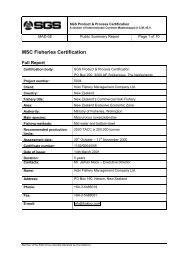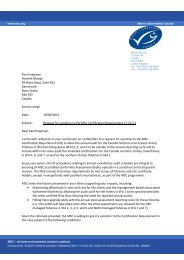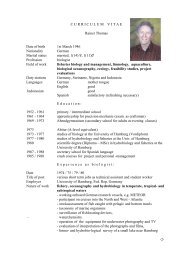SGS Product & Process Certification - Marine Stewardship Council
SGS Product & Process Certification - Marine Stewardship Council
SGS Product & Process Certification - Marine Stewardship Council
You also want an ePaper? Increase the reach of your titles
YUMPU automatically turns print PDFs into web optimized ePapers that Google loves.
9.2.2 SICA<br />
A SICA proceeds in several steps. These steps and the results of the consequent stages are<br />
described here.<br />
Scoping for risk-causing activities:<br />
As a first step, the stakeholder group must decide on a list of activities that may have an impact<br />
on the target species population, other species, habitat or ecosystem. Based on the expert<br />
judgment of the assessment team members and stakeholders present at the meeting, the<br />
activities that may cause a risk to the different components were identified and evaluated<br />
qualitatively. The results of this first step are presented in Table 3.<br />
Table 3. Identification table of risk causing effects (** = risk causing effect, * = little effect, - =<br />
no effect, Na = not applicable)<br />
Activity Stock By catch Discard ETP Habitat Ecosystem<br />
Direct<br />
Capture<br />
** * - - - -<br />
Gear loss * * Na Na - *<br />
Unobserved<br />
mortality<br />
* * Na Na Na -<br />
Discarding<br />
Other:<br />
* * Na Na Na Na<br />
Bait collection - - - - * -<br />
Steaming - - - * - -<br />
Anchoring - - - - * -<br />
Littering - - - - * -<br />
From this rather subjective analysis it was concluded that the ‗worst plausible case‘ is the<br />
impact of the fishery (direct capture) on the sea bass stock (sub-component) in the North Sea.<br />
Scale and intensity of fishery. In the second step of the SICA, the stakeholder group is asked<br />
to consider the spatial scale, the temporal scale and the intensity of each activity, in this case<br />
the direct capture of sea bass (Table 4). These scores do not feed directly into the final score<br />
for the SICA, but help to start off the discussion and ease participants into the idea of allocating<br />
scores.<br />
Spatial scale<br />
The spatial scale score depends on the overlap of the activity with the geographical distribution<br />
of the stock. A spatial scale score of 4 was given because the UoC fishes for sea bass over a<br />
wide area of the southern North Sea, but less than 50% of the stock‘s geographical range.<br />
Temporal scale<br />
Though the UoC takes place during about 60-90 days in a year, a temporal scale score of 4<br />
was given because there are other seasonal fisheries for bass in coastal areas of the North<br />
Sea and in the eastern English Channel Therefore it has been assumed that the fishery for<br />
bass takes place during 100-200 days a year.<br />
Page 40 of 151





